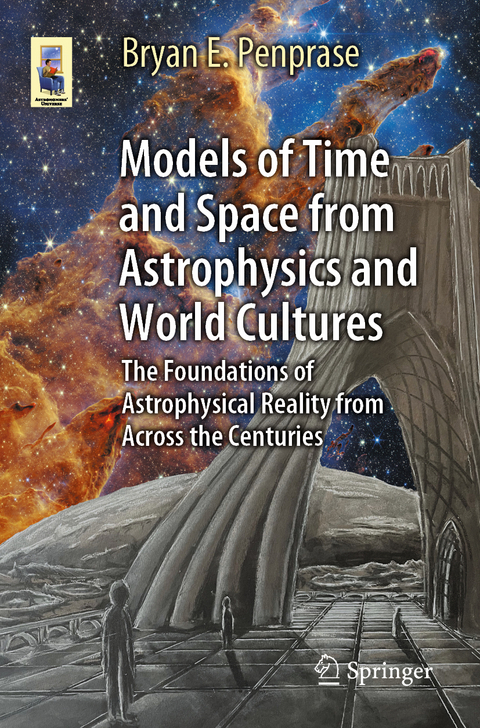
Models of Time and Space from Astrophysics and World Cultures
Springer International Publishing (Verlag)
978-3-031-27889-1 (ISBN)
Models of Time and Space from Astrophysics and World Cultures explores how our conceptions of time, space, and the physical universe have evolved across cultures throughout the centuries. Developed with a humanistic approach, this book blends historical sources, biographical profiles of exceptional scientists, and the latest discoveries in both astrophysics and particle physics. This rich read describes the incredible insights and ultimate limits of our knowledge, the physical universe, and how ideas old and new have converged, across the world, to build our current understanding of reality. From the Large Hadron Collider to the James Webb Space Telescope, we have mapped the universe from the smallest to largest scales; allowing us to gain fundamental knowledge that has transformed our understanding of the universe.
The chapters herein will teach you about dark matter and dark energy, gravitational waves and other complex parts of the cosmos. Along the way, you will learn a thing or two about quantum mechanics, parallel universes, and the ultimate boundaries of the observable universe. This book cultivates insight from a variety of cultural traditions, including perspectives from both modern and ancient cultures, in order to show how our modern conceptions of space and time have arisen from the ongoing explorations within ancient world civilizations.
It is a valuable, intriguing and insightful volume for those interested in the fields of historical astronomy and cultural astronomy, as well as for anyone interested in learning about the latest finds from the field of physics and astrophysics.
Bryan Penprase is the Vice President for Sponsored Research and External Academic Relations at Soka University of America, where he conducts astrophysics research, teaches courses in astronomy, and develops new educational collaborations with universities and colleges. He formerly served as Dean of Faculty, where he managed the design and implementation of a new Concentration in Life Sciences and developed new courses in astronomy. Bryan has been developing new approaches to teaching and learning, with an emphasis on intercultural understanding, in the USA, Singapore and India. He previously was a Professor of Science and founding Director of the Teaching and Learning Center at Yale-NUS College in Singapore, and served as an American Council on Education (ACE) fellow in 2012-13. Bryan served for 20 years as a professor of Physics and Astronomy at Pomona College, where he was department chair and observatory director. He received both a BS in Physics and an MS in Applied Physics from Stanford University in 1985, and a PhD from the University of Chicago in Astronomy and Astrophysics in 1992. Bryan’s research includes nearly all aspects of observational astrophysics. He is the author of two books, “STEM Education for the 21st Century” and “The Power of Stars”, both published by Springer. Bryan has authored or coauthored over 58 peer-reviewed research articles in astrophysics, and his most recent research programs include collaboration with Caltech to develop the Zwicky Transient Facility (ZTF) and a Global Relay of Observatories known as GROWTH. His work on cultural approaches to astronomy and science has included leading archaeoastronomy expeditions and short courses in New Mexico, Wyoming, Utah, India, Borneo, and across China.
Chapter 1. Exploring the Earth and Sky.- Chapter 2. The Geography of Earth Beyond the Horizon.- Chapter 3. The Geography of the Skies.- Chapter 4. Early Telescopes and Models of the Universe.- Chapter 5. Early Maps and Models of Galaxies.- Chapter 6. The Discovery of the Big Bang.- Chapter 7. The Nature of Light.- chapter 8. Spacetime and Curved Space.- Chapter 9. Mapping Space to the Edge of the Observable Universe.- Chapter 10. Our Light Sphere and Horizon.- chapter 11. The Quantum World - Physics of the Very Small.- Chapter 12. Accelerators and Mapping the Particle Universe.- Chapter 13. The Higgs Boson and Models of the Early Universe.- Chapter 14. Exploring the Invisible Universe.- Chapter 15. Physics of the Vacuum and Multiverses.
"The soft-cover book is printed on high-quality paper, a good choice given the many full-colour illustrations, showing historical charts, modern astronomical images, or graphics ... . Presentation and layout of the medium-format publication are convincing. The text is fluid, informative, and easy to understand. ... The content is organized more or less chronologically and reflects the current state of knowledge. There are 15 chapters with up to nine subchapters. References (literature, internet sources) are given below each chapter." (Wolfgang Steinicke, The Observatory, Vol. 144 (1300), June, 2024)
| Erscheinungsdatum | 26.07.2023 |
|---|---|
| Reihe/Serie | Astronomers' Universe |
| Zusatzinfo | XV, 305 p. 151 illus., 125 illus. in color. |
| Verlagsort | Cham |
| Sprache | englisch |
| Maße | 155 x 235 mm |
| Gewicht | 498 g |
| Themenwelt | Geisteswissenschaften ► Religion / Theologie |
| Naturwissenschaften ► Physik / Astronomie ► Astronomie / Astrophysik | |
| Schlagworte | beyond observable universe • buddhist metaphysics • History of Astrophysics • human concepts of space • human concepts of time • limits of the universe • modern astrophysics explained • objective reality studies • physical reality studies • Quantum Mechanics Explained • the power of stars • universe light cone |
| ISBN-10 | 3-031-27889-5 / 3031278895 |
| ISBN-13 | 978-3-031-27889-1 / 9783031278891 |
| Zustand | Neuware |
| Haben Sie eine Frage zum Produkt? |
aus dem Bereich


